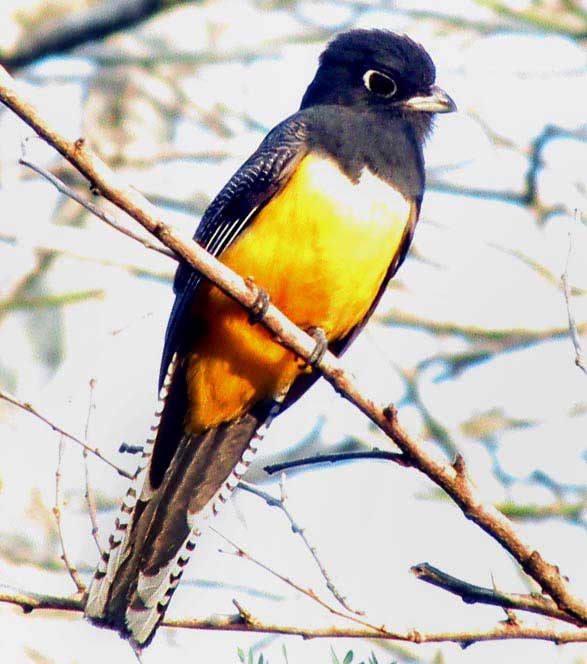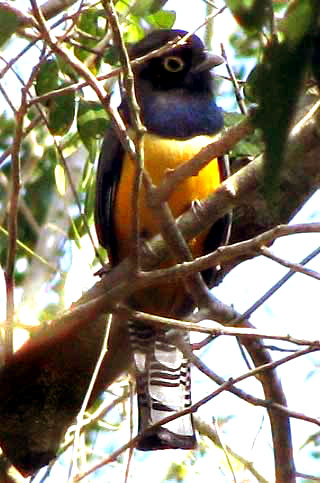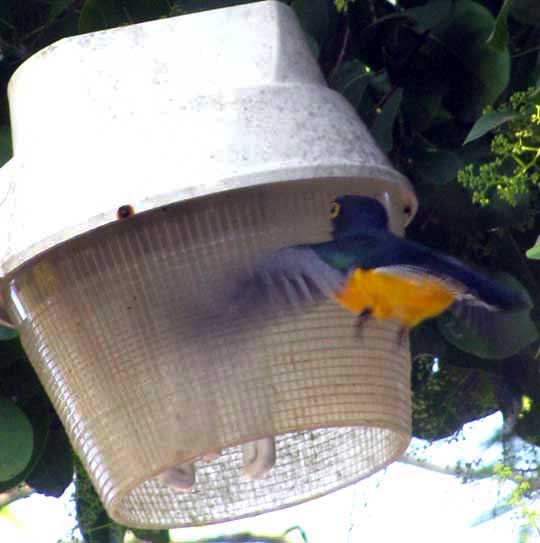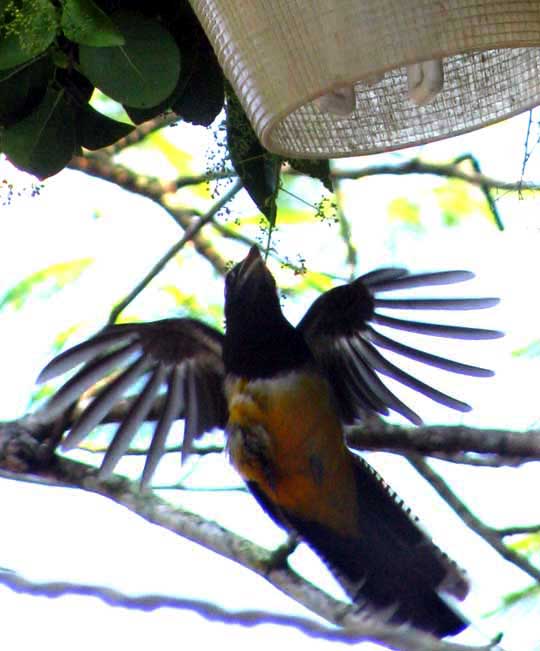Excerpts from Jim Conrad's
Naturalist Newsletter

from the April 24, 2016 Newsletter issued from Hacienda Chichen Resort beside Chichén Itzá Ruins, central Yucatán, MÉXICO; limestone bedrock, elevation ~39m (~128ft), ~N20.676°, ~W88.569°
SUN-BASKING TROGON
For several mornings in a row a trogon with a yellow breast has perched awhile next to the hut, basking in early morning sunlight, as shown above. We've documented two trogon species here at the Hacienda. There's the Violaceous Trogon*, profiled on this page, and there's the Black-headed Trogon
If you compare pictures on these pages you'll wonder what the difference is between the two species. Most of the other seven trogon species in Mexico have red breasts, and tails with very different patterns underneath. So, why do two almost identical trogon species turn up here?
A good guess is that sometime in the past the distribution area of the yellow-breasted ancestor of our two Yucatan species fractured into two or more "islands" surrounded by habitats the trogons couldn't live in. Birds in each separate island population continued evolving, adapting to local conditions, until they became so different from one another that members of the two populations no longer could interbreed. Then maybe the climate changed again, causing the isolated populations to coalesce into one big distribution area, like before, but this time with two yellow-breasted species who couldn't interbreed. Other explanations for how two very similar species can turn up in one place are possible, but the one just described is a typical scenario.
Our two similar-looking, yellow-breasted species sound a little different from one another, the Violaceous's "kyow-kyow-kyow... " call being "not as hard or hollow as Black-headed Trogon," according to Mexican bird-guru Steve Howell. If you take a picture like ours and study it on your computer screen, you can see other differences as well.
The Violaceous's wings display more white streaks and bars than the Black-headed's. The one in the picture shows a good bit of white. The Violaceous's undertail displays more small, black bars along the edges, as shown in our picture, than the Black-headed's, whose tail edges are more solid black. Also, trogon eye rings tend to be of equal width all around the eye, but the female Violaceous's eye ring is thicker in the front and back than the top and bottom, forming "crescents" fore and aft -- as displayed by our bird.
from the March 21, 2010 Newsletter issued from Hacienda Chichen Resort beside Chichén Itzá Ruins, central Yucatán, MÉXICO; limestone bedrock, elevation ~39m (~128ft), ~N20.676°, ~W88.569°
AT THE HALTÚN WATERING HOLE

With the dry season bearing down hard now, every day I fill the haltunes, or natural watering holes in limestone rock, and all day long, every day, there's a continual parade of birds who arrive, land in branches above the haltunes, look around and look some more, then finally descend to drink their fill. Despite the heat often I throw an old, brown poncho over myself for camouflage and sit with my camera about 20 feet away, and wait.
Not all visitors land to drink. The Gartered Trogon, TROGON CALIGATUS, sails in silently, sets himself in a shadowy, cluttered part of a tree, and just watches, never twitting a feather or making a sound. Trogons mostly eat fruit, so maybe they're not as thirsty as the seed and insect eaters. Maybe they're just attracted by the commotion caused by all the other birds. There's one above a haltún, eyeing the circus, in the above picture.
Violaceous Trogons are fairly common, though hard to see because of their habitual stillness and choice of secretive perches. They specialize in humid to semiarid forests and forest edges, plantations and mangroves, and are distributed from eastern Mexico south into Ecuador and Brazil.
from the April 17, 2011 Newsletter issued from Hacienda Chichen Resort beside Chichén Itzá Ruins, central Yucatán, MÉXICO; limestone bedrock, elevation ~39m (~128ft), ~N20.676°, ~W88.569°
TROGON AT THE SECURITY LAMP
For weeks in early mornings one or more Violaceous Trogons have perched near a certain security lamp in the parking lot from where for half an hour or so they repeatedly fly up to the lamp and peck at it, as shown below:

I'd always thought of trogons as strictly fruit-eaters but it looks to me as if these birds are picking off bugs attracted to the light at night. At dawn the bugs apparently crawl up the outside plastic shade and shelter between the top of the shade and the metal rim it fits into. Consulting Howell's A Guide to The Birds of Mexico and Northern Central America, I read that trogon food is "mostly fruit and insects plucked from outer branches and foliage in short sallying flights," so Howell already knew what I'm just finding out.
While photographing one trogon's bug-plucking forays I got the interesting shot shown below:

What fascinates me is the large amount of space between the wing feathers. Finally I realized that since the trogon is flying upwards he must orient his feathers horizontally within his vertically aligned wings, to provide the most wing surface-area for pushing down against the air. Seen from the side it's like looking through Venetian blinds with their vanes set in the horizontal position. I don't think I've ever seen a bird exercising such control over individual wing feathers.
from the May 2, 2010 Newsletter issued from Hacienda Chichen Resort beside Chichén Itzá Ruins, central Yucatán, MÉXICO; limestone bedrock, elevation ~39m (~128ft), ~N20.676°, ~W88.569°
TROGON VIDEO
It's finally occurred to me that since my camera includes a very simple video-making option I need to experiment with providing links in this Newsletter to some videos. My first effort can be viewed, I hope, below:
That's a male Violaceous Trogon at midday with his wings held out because of the very high humidity and temperature in the low 90s (34° C). Since my $335 Canon PowerShot SX100IS bought off-the-shelf at Wal-Mart in Natchez, Mississippi is meant as a handheld camera for still photography, the video strikes me as pretty good. I did use a stick to steady the camera but it's still pretty shaky. I'm especially happy with the audio.
Nowadays at any time of the day you're likely to hear this species calling its typical trogon kow-kow-kow-kow... call, on and on until sometimes you wish he'd stop. That's the call I was planning to show you. However, as soon as I clicked the camera's shutter this bird stopped his normal calling, looked over his shoulder and started making a completely different call.